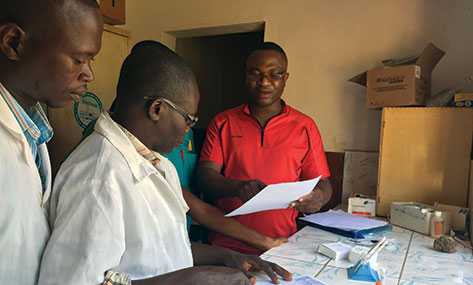Enhanced Ebola Detection and Response in Guinea and Liberia
A Tale of Two Outbreaks

FETP resident Gauthier Mubenga reviewing data collection with laboratorians at the Yomou prefectural hospital in N'Zérékoré region of Guinea
Helping to strengthen public health systems around the world not only helps to protect populations where outbreaks begin; it’s an effective and efficient way to protect Americans from diseases and other health threats that begin abroad. In March 2014, limited public health infrastructure and workforce capabilities, as well as weak surveillance and response systems in Guinea, Liberia, and Sierra Leone catalyzed widespread transmission of the Ebola virus in West Africa. The 2014 outbreak recorded more than 28,000 cases of Ebola and more than 11,000 deaths. CDC joined other partners to help contain the epidemic and build the capacities of public health staff in the affected countries.
The enhanced ability to rapidly detect and respond to Ebola created by the improved capacities in Guinea and Liberia were demonstrated when, two years later, new cases of Ebola were identified in Guinea and Ebola spread to Liberia. The response to the new cluster was swift and robust; instead of spreading unchecked, the new outbreak was limited to a total of 13 cases and 9 deaths. This “Tale of Two Outbreaks” reinforces the impact of strong surveillance and response systems, and a trained workforce, resulting from investments in building public health capacity and illustrates how such efforts enhance global health security.
- Page last reviewed: March 24, 2017
- Page last updated: March 24, 2017
- Content source:


 ShareCompartir
ShareCompartir